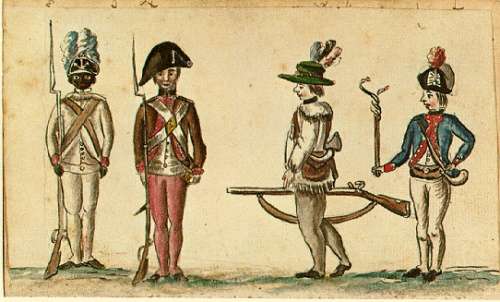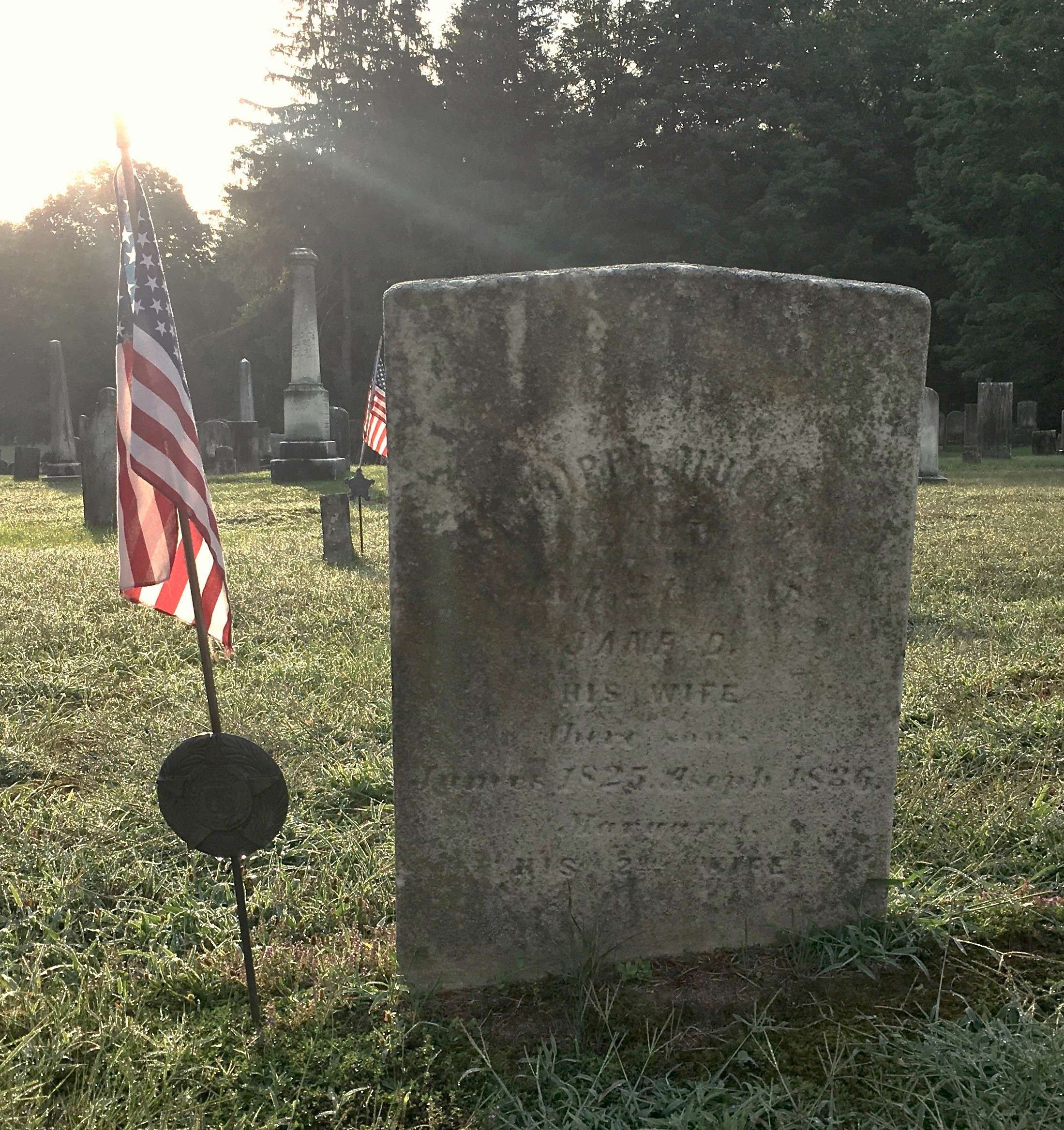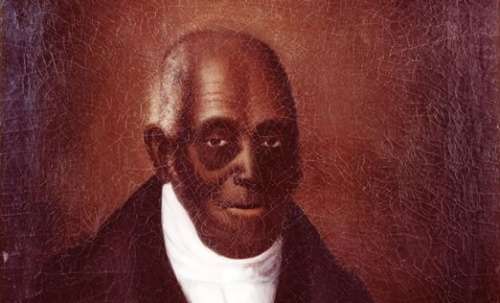After decades of neglect the common burial grounds of slaves are now being documented, honored and preserved from New York to Mississippi and beyond. But Agrippa Hull was buried among his white countrymen in a dignified distinct tomb, as the oldest surviving American Revolutionary War veteran in the quintessentially New England town of Stockbridge, Mass.

Agrippa Hull
He travelled a unique road.
Agrippa Hull
He lived during an extremely tenuous time for black people in America. Yet Agrippa Hull seems to have graciously navigated the dark clouds of prejudice. The revolutionaries demanded freedom and independence from colonial rule in a largely white context of self-determination. Yet as soon as he could, Hull took a determined stance by enlisting in the Continental Army. And every surviving anecdote and record confirms that Hull lived magnanimously, served effectively and was remembered fondly.
Today we can barely imagine the circumstances in which Hull lived. In the early 1700s the estimated number of slaves in the Massachusetts colony alone reached approximately 3.5 percent of the total population, or some 2,000. But Agrippa Hull was born in Northampton, Mass., to free African-American parents around the year 1759. Plagued by poverty, they had to give up their son at the age of six. They sent him to live with a family of free blacks that could better care for him in Stockbridge.
Agrippa Hull ultimately achieved a level of prosperity and respect that many other black Americans did not. As a Continental Army soldier, Hull witnessed the social and economic spectrums along which people of color lived in the 18th century. And he distinguished himself by how he moved along that spectrum during his long lifetime.
Triangular Trade
Discordant views, policies and practices of bondage pervaded the colonies without any central authority over the issue. Slave-trading flourished in Triangular Trade: English traders carried manufactured goods to Africa and sold them there for slaves. Black men and women were bound then shipped to the New World. There the slavers exchanged them for such raw materials as lumber, furs, tobacco and sugar which in turn was exported to re-supply English factories.
People sometimes romanticize freedom of religion as the reason migrants left Europe for the New World. But with the growth of the new nation, people of faith did form coalitions which pressed authorities hard to end slavery. They were guided by the Bible’s Golden Rule, “Do unto others as you would have them do unto you.”

James Oglethorpe
In the southern colonies bondage was by no means universally accepted. Consider the policy of James Oglethorpe, the British governor of the colony of Georgia, created in 1732. In Great Britain, Oglethorpe had a reputation as a humanitarian and social reformer because he worked to improve the deplorable conditions in debtors’ prisons. From its inception Oglethorpe outright banned slavery in Georgia as incompatible with British common law. Not until Oglethorpe left Georgia in 1743 did planters and ship owners overturn his policy and introduce slavery.
England prohibited the keeping of slaves following a 1772 lawsuit known as Somersett’s Case. But outside of her borders hypocrisy ruled. The slave trade was tolerated and English merchants thrived.
Private Agrippa Hull
With the outbreak of war all 13 colonies desperately needed volunteers. The southern colonies, with the exception of Maryland, refused to enlist black men. New England units accepted volunteers regardless of race. Surviving muster roles show Agrippa Hull, at age 18, enlisted as a free black man with the Continental Army. In 2008, the book Friends of Liberty popularized the story of his service.

Continental Army foot soldiers.
Records show Hull as a private in the First Stockbridge Company on May 1, 1777. He was one of an estimated 5,500 men of color (black, native American and mulatto) from throughout the colonies who joined the American war effort. When posted to then-Brig. Gen. John Paterson’s brigade of the First Massachusetts Regiment, Berkshire County enlistment rolls give Hull’s physical characteristics as being “five feet seven inches tall; complexion, black; hair, wool.”
John Paterson
Without weapons training, it was military rank not race which demanded Hull serve Paterson as his valet (or “orderly” or “personal assistant”). In order to carry out his duties he had to depend on the cooperation, if not respect, of other white men of his own rank. In that first year of his service Hull stood by Paterson as he led troops in Saratoga. Then together they endured the brutal winter of Valley Forge to help assure Washington’s glory at Monmouth Court House in June 1778.

Kosciuscko
Later that year Paterson was put in command of the garrison at West Point. There the venerated engineer and tactician Tadeus Kosciuscko worked to fortify that strategic base along the Hudson River. Through interactions between the commander and the engineer, Kosciuscko is recorded as impressed by Hull’s wit and intelligence. As a gesture of goodwill, Paterson reassigned Hull to Kosciuscko’s camp as his valet in May 1779.

West Point ca 1831, from Phillipstown.
Travels with Agrippa Hull
Kosciuscko’s work on the defense of West Point added to his distinction. In 1780 Washington named him lead engineer in support of the southern army. Militiamen rarely served outside of their home region. Yet Hull volunteered to stay by Kosciuscko’s side. Detached from his Massachusetts regiment, he traveled hundreds of miles south into the Carolinas, where the most arduous fighting of the war took place. As the two men traveled farther from New England they increasingly witnessed people’s struggles with slavery.
Spanish Florida offered runaways freedom on two conditions: convert to Roman Catholicism and serve four years in the military. Most who successfully took up that offer settled in Gracia Real de Santa Teresa de Mose, just north of St. Augustine. There a fort was built, establishing the first legally sanctioned free black settlement in North America. In a counterbid to drive a wedge between abolitionists and slavers and to draw volunteers to their ranks, the British governor of Virginia, Lord Dunmore, adopted the Spanish policy of granting freedom to runaway slaves. The British offered emancipation to all who escaped and crossed over to their side.
Upon reporting in the Carolinas, Hull and Kosciuscko joined the battle-worn Americans serving under Gen. Nathanael Greene. Half were undernourished and no longer fit for duty. They then witnessed firsthand the desperate plight of enslaved, barefoot and shirtless blacks answering Lord Dunmore’s invitation, fleeing plantations for freedom. In fact, Dunmore’s scheme resulted in what historians recognized as the largest flight of slaves prior to the Civil War era.

The Battle of Eutaw Springs
In September 1781, another anecdote emerged to burnish Hull’s resume after the Battle of Eutaw Springs. Hull went to assist overworked surgeons laboring to save the lives of some 380 American wounded. And according to MassMoments, “the horror of amputations they performed stayed with [Hull] for the rest of his life.”
Home Again
At the end of the war in 1783 the Continental Army disbanded. To Hull’s great delight, on July 23 at West Point Gen. George Washington himself formally signed and dated his discharge papers. Returning home to Stockbridge, Hull promptly found paid work as a manual laborer in the household of a prominent lawyer, Theodore Sedgwick (1746-1813). Sedgwick was the lawyer who in 1781 argued the case that freed Elizabeth Freeman – the first in which a black woman sued and won her liberty. For all practical purposes the case set the precedent for ending slavery in Massachusetts.

Elizabeth Freeman played an important role in ending the slave trade.
In order to qualify for a service pension, soldiers had to submit their discharge papers to verify their time. The patriot Agrippa Hull was so proud that Washington signed his discharge papers he refused to ever part with them. Writing to the pension board on Hull’s behalf, Sedgwick explained that Hull would “rather forego his pension than [give up] the discharge papers.”
By 1785 Hull had saved enough money to buy his own land and eventually became a prominent Stockbridge landowner in his own right. He established his own household and married a woman by the name of Jane Darby. It turns out that Sedgwick negotiated Darby’s freedom too, after she managed to escape her owners.

Theodore Sedgwick
Abolitionist strength and the force of Massachusetts law grew so much that the 1790 census shows no enslaved people in Stockbridge or anywhere in the Commonwealth of Massachusetts. Yet the colonial legacy of unbridled British commerce in slaves continued to corrupt America for decades.
A Stockbridge Anecdote
Hull’s life showed the absurdity of prejudice. Every surviving memoir describes him as a joy to work with and a man who served the cause of the Revolution with distinction. On February 17, 2015 the Berkshire Edge, a local news and features publication, printed “a favorite Stockbridge anecdote”:
“A haughty man attended church to listen to a discourse from a distinguished mulatto preacher. On coming out of church the man asked Hull, ‘Well how do you like that n[…] preaching?’ To which Hull is to have responded ‘Sir, he was half black and half white; …I liked my half, how did you like yours?’ ”

Gravestone of Agrippa Hull
Agrippa Hull died in 1848 at the age of 89 as the oldest Revolutionary War veteran in Stockbridge. A fresh American flag is placed at his grave every Memorial Day.
The author of this story, John E. Happ, has been immersed in the contrasting narratives of foreign cultures since college in Spain and speaks five languages. His varied assignments in Germany, Switzerland, the Philippines and Japan contribute greatly to his research and perspectives. Happ is a contributing author at the Journal of the American Revolution, has written for the web site The 75th Artillery C.A.C During World War One and the adventure magazine, Atlantic Coastal Kayaker.
